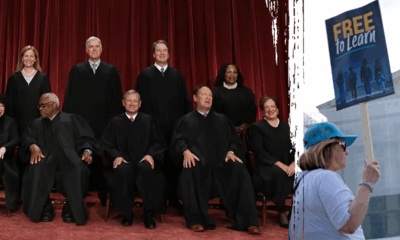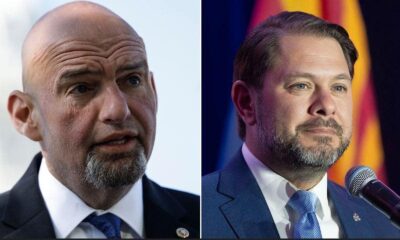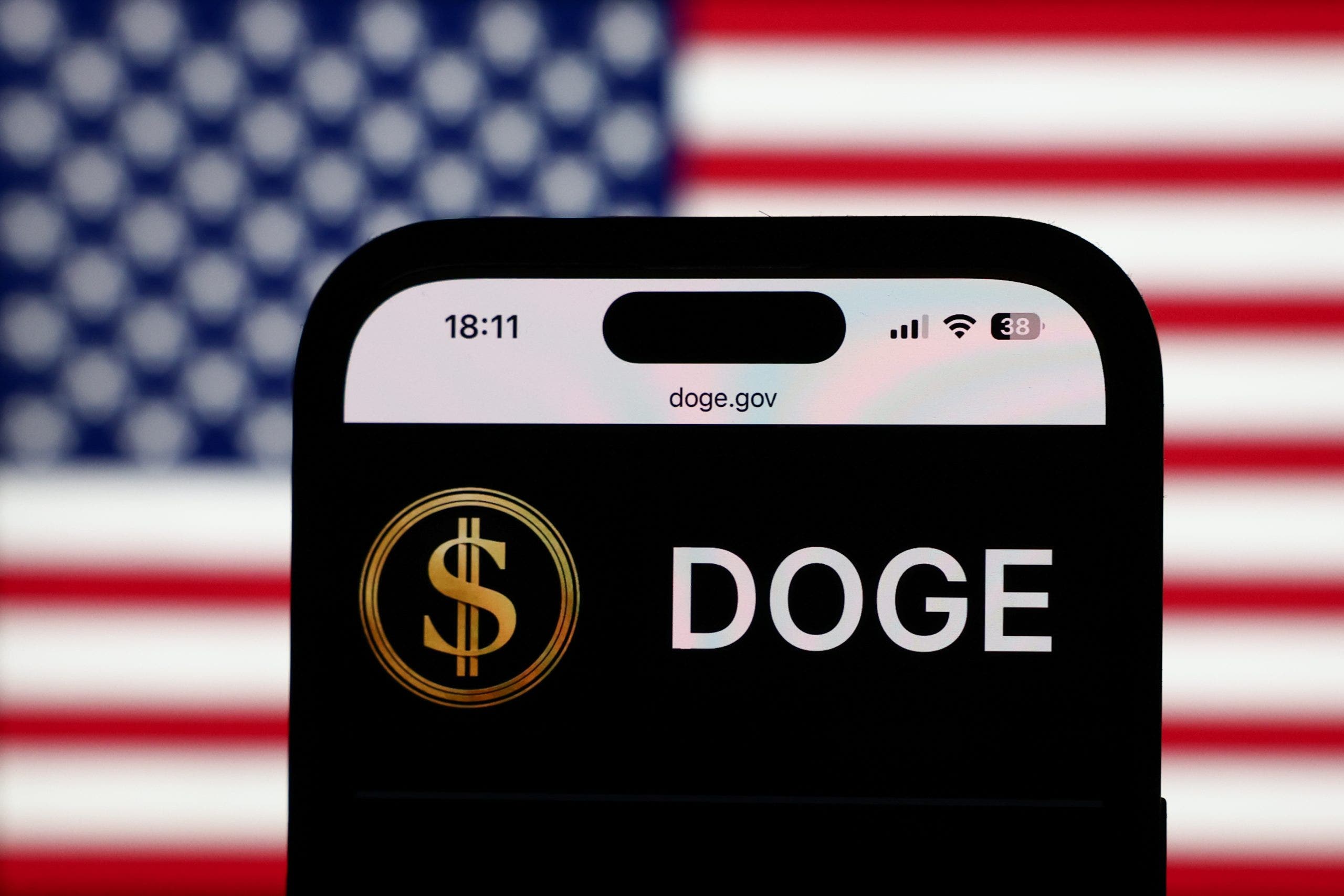Business
Uber strikes deal to partner with Yellow Cab, other taxi fleets in Southern California

Uber took another leap forward in its plan to pull more taxis onto its platform, announcing a partnership on Tuesday with Los Angeles Yellow Cab and other taxi fleets in Southern California.
The deal gives six taxi fleets operating in Los Angeles, Orange and San Diego counties access to trip referrals from Uber.
Uber, soon after it was conceived in 2008 as a luxury car service, set out to disrupt the U.S. taxi industry and went on to aggressively elbow its way into the global transportation industry. But Uber is now hoping that the traditional taxi business, its former enemy, will support its next wave of growth.
Uber at first struck partnerships with taxi companies mostly outside the United States. Last year it unveiled an agreement in the U.S., announcing a deal with taxi companies in New York City and a similar agreement with Flywheel Technologies in San Francisco.
“As we continue to strengthen our relationship with the taxi industry, we’re excited to announce our partnership,” Camiel Irving, Uber’s general manager of U.S. and Canada mobility, said in an emailed statement. “We’re encouraged by the support from local regulators in California and look forward to continuing to work closely with our taxi partners to bring the benefits of this program to more taxi drivers and cities throughout the country.”
William Rouse, chief executive of the Southern California taxi operations involved in the deal, said teaming up with Uber gives taxi drivers access to more riders, while aiding Uber with an infusion of hundreds of additional drivers.
“We’re totally excited about this partnership,” Rouse said. “We’re totally happy with this. This is going to put more money in the drivers’ pockets.”
He said that over the years the taxi industry has lost much of its night business, with trip volume down during those hours; he sees the partnership as a “huge opportunity” to rebuild that presence.
Rouse’s six taxi companies total about 1,200 vehicles; they include San Diego Yellow Cab, California Yellow Cab, Los Angeles Yellow Cab, Long Beach Yellow Cab, Fiesta Taxi Cooperative Inc. and United Checker Cab.
Uber used to call the taxi industry corrupt and greedy, and the taxi industry has long said Uber and other rideshare giants that burst on the scene wrecked their business model and destroyed their drivers livelihoods.
But Rouse said he prefers not to focus on the sordid past. He said Uber first reached out to the taxi industry at a trade association conference a few years ago: “It was surprising, but I think everything’s gone really well. In my personal discussions with [Uber] I’ve seen nothing but professionalism.”
Uber and the taxi companies’ technology will be integrated in phases. At first, Uber’s app will be loaded onto drivers tablets, and drivers will receive calls via the app. Eventually, Uber will integrate directly with the taxi companies’ dispatch system.
L.A. Yellow Cab and its partner fleets that Rouse oversees all offer rides on digital platform RideYellow. Once taxi drivers sign up, they will begin to receive Uber trip referrals in the coming weeks.
After Uber’s San Francisco taxi pilot program went public last year, some taxi drivers voiced concerns about Uber’s continually growing presence. Uber pointed to a quarterly analysis by the San Francisco Municipal Transportation Agency that found drivers who provided Uber trips from April through June of this year earned an average of $1,767 a month from those trips, which was 23.8% more on average than taxi drivers who did not provide Uber trips.
Although Uber is regulated at the state level, taxi companies are regulated locally, meaning Rouse’s taxi fleets are largely overseen by the cities in which they operate.
Last year, the Los Angeles City Council approved an ordinance to offer digital upgrades to taxis, giving riders better access to taxis via cellphone apps such as those Uber and Lyft operate.
The measure gave ride-hail apps access to traffic and other city data intended to make dispatching drivers more efficient. It also removed caps on the number of authorized cabs receiving 10-year permits to operate. City officials had said they would monitor how well the system was working and analyze drivers’ wages, fleet size, wait times and ride frequency.

Business
Contributor: A Trump deregulator may set us up for a sequel to the 2008 crisis

The movie “The Big Short” — dramatizing the reckless behavior in the banking and mortgage industries that contributed to the 2008 financial crisis — captures much of Wall Street’s misconduct but overlooks a central player in the collapse: the federal government, specifically through Fannie Mae and Freddie Mac.
These two government-created and government-sponsored enterprises encouraged lenders to issue risky home loans by effectively making taxpayers co-sign the mortgages. This setup incentivized dangerous lending practices that inflated the housing bubble, eventually leading to catastrophic economic consequences.
Another critical but overlooked factor in the collapse was the Community Reinvestment Act. This federal law was intended to combat discriminatory lending practices but instead created substantial market distortions by pressuring banks to extend loans to borrowers who might otherwise have been deemed too risky. Under threat of regulatory penalties, banks significantly loosened lending standards — again, inflating the housing bubble.
After the bubble inevitably burst, Fannie and Freddie were placed under conservatorship by the Federal Housing Finance Agency. The conservatorship imposed rules aimed at preventing future taxpayer-funded bailouts and protecting the economy from government-fueled market distortions.
Now, President Trump’s appointee to lead that agency, Bill Pulte, is considering ending this conservatorship without addressing the core structural flaw that fueled the problem in the first place: implicit government guarantees backing all Fannie and Freddie mortgages. If Pulte proceeds without implementing real reform, taxpayers on Main Street are once again likely to be exposed to significant financial risks as they are conscripted into subsidizing lucrative deals for Wall Street.
Without genuine reform, the incentives and practices that led to the crisis remain unchanged, setting the stage for a repeat disaster.
Pulte’s proposal isn’t likely to unleash free-market policies. Instead, it could further rig the market in favor of hedge funds holding substantial stakes in Fannie and Freddie, allowing them to profit enormously from the potential upside, while leaving taxpayers to bear all the downside risks.
A meaningful solution requires Fannie and Freddie to significantly strengthen their capital reserves. The two government-sponsored enterprises still remain dangerously undercapitalized. A report from JP Morgan Chase describes it this way: “Despite steady growth in [their net worth], the GSEs remain well below the minimum regulatory capital framework requirements set by the Federal Housing Finance Agency in 2020.” Imposing robust capital requirements similar to those that govern private banks would oblige the two enterprises to internalize their risks, promoting genuine market discipline and accountability.
Further reforms should address transparency and oversight. Enhanced disclosure standards would allow investors, regulators and the public to better assess risks. Additionally, limiting the types of mortgages these entities can guarantee could reduce exposure to the riskiest loans, further protecting taxpayers. Implementing clear rules that prevent Fannie and Freddie from venturing into speculative financial products would also mitigate potential market distortions.
Critically, the federal government must clearly communicate that future bailouts are not an option. Explicitly removing government guarantees would compel Fannie and Freddie to operate responsibly, knowing that reckless behavior will lead to their insolvency, not to another taxpayer rescue. Clear legal separation from government backing is essential to prevent moral hazard.
The combination of government guarantees, regulatory pressure from policies such as the Community Reinvestment Act and inadequate capital standards created the perfect storm for the 2008 financial crisis. Ignoring these lessons and repeating past mistakes would inevitably lead to a similar disaster.
Proponents of prematurely releasing Fannie and Freddie argue that market conditions have changed and risk management has improved. Yet, history repeatedly demonstrates that without structural changes, financial entities — particularly those shielded by government guarantees — inevitably revert to risky behavior when market pressures and profit incentives align. Markets function best when participants bear the full consequences of their decisions, something impossible under the current structure of these government-sponsored enterprises.
Ultimately, the only responsible approach is removing taxpayers from the equation entirely. Fannie Mae and Freddie Mac should participate in the mortgage market only as fully private entities, without any implicit government guarantees.
The American public doesn’t need a sequel to “The Big Short.” The painful lessons of the 2008 crisis are too recent and too severe to be ignored or forgotten. Market discipline, fiscal responsibility and genuine reform — not government-backed risk-taking — must guide our approach going forward. We can only hope that the Trump administration chooses fiscal responsibility over risky experiments that history has already shown end in disaster.
Veronique de Rugy is a senior research fellow at the Mercatus Center at George Mason University. This article was produced in collaboration with Creators Syndicate.
Business
Palisades Village to reopen with Elyse Walker rebuilding flagship store

Elyse Walker made a bet in 1999: that residents of Pacific Palisades and Brentwood would rather shop for designer fashions in their neighborhood than drive to Beverly Hills.
Her eponymous boutique, initially just 800 square feet, became the cornerstone of a retail empire that now stretches from Tribeca to Newport Beach, drawing celebrities such as Jennifer Garner and Kate Hudson. It also propelled a renewal of downtown Palisades, with new restaurants and boutiques moving in.
That all changed on Jan. 7, when the Palisades fire leveled Walker’s flagship store and thousands of homes and other businesses.
A man rides a scooter past a burning business in Palisades Village on Jan. 8.
(Brian van der Brug / Los Angeles Times)
On Wednesday, Walker proudly announced her next bet on the neighborhood where she raised her two sons.
In downtown Palisades, she and developer Rick Caruso revealed that Caruso’s Palisades Village shopping center will reopen in mid-2026 and that her flagship store, elysewalker, will become its newest marquee tenant.
“I hope that this serves as the catalyst for other retailers and brands and big businesses and small businesses to come back to the Palisades, Malibu, Altadena and Pasadena,” Walker said in an interview. “Twenty-five years ago, we planted seeds in this community, and now we are doing it again.”
Caruso told The Times that later this year, he plans to resume the Palisades Village annual Christmas tree and menorah lighting. He said he will also underwrite the cost of new landscaping and sidewalks in the streets around the shopping center.
The goal, he said, is to create a visible anchor to a town in the midst of a massive recovery and to accelerate the return of a vibrant, bustling community.
“This is a really big deal,” Caruso said. “When a retailer like Elyse opens a store in a community, that’s a powerful voice of confidence that there’s a bright future here. I really do believe with her and our organization, the rebirth of the Palisades is going to be unstoppable.”
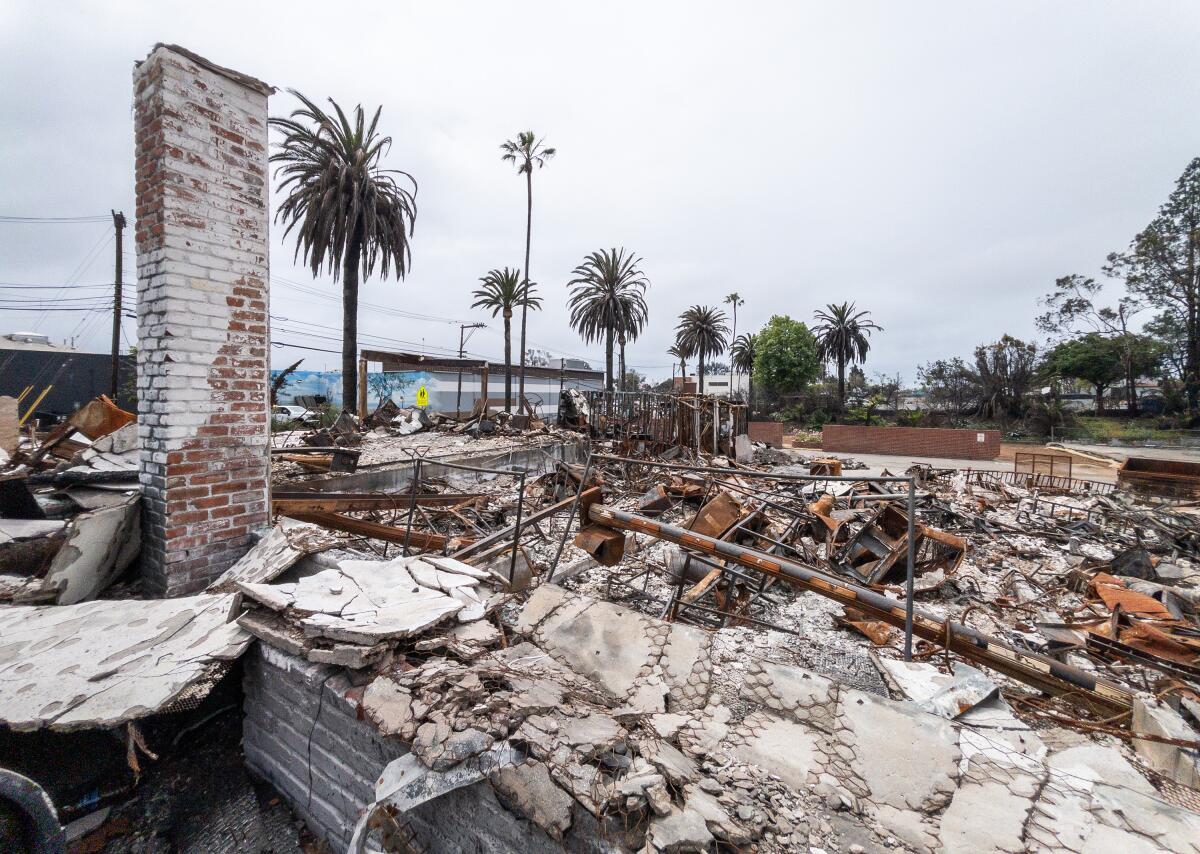
The location of Fashion designer Elyse Walker’s former flagship store in Pacific Palisades that was destroyed in the Palisades fire on Jan. 7.
(Myung J. Chun/Los Angeles Times)
The news came during a frustrating and uncertain period as Palisades residents recover from the devastation of the wildfire and grapple with the mass displacement of their community. Thousands have relocated to disparate parts of Southern California or are scattered across the U.S.
“The fact that we have this hub in the middle of town is a ray of hope that we can get back sooner,” said Chris Feil, a Palisades native who moved six times after the fire before settling in a rental in Manhattan Beach. His wife, Mia Feil, said she gets emotional thinking of what was lost in the blaze. The couple is now in the early stages of rebuilding.
“We’re all sort of traumatized by the loss of our community,” she said, listing the impromptu gathering at restaurants, Saturday baseball games, the annual Christmas tree lighting and the Fourth of July parade. “Having all those things back is truly the lifeline and joy in the neighborhood — that’s what makes the Palisades so special. It’s a small town in a big city.”
Walker chose to open her shop on Antioch Street more than 25 years ago so that she could easily walk to her sons’ school.
“We were between three churches, two coffee shops and five schools — it had nothing to do with co-tenancy yet,” Walker said. “We just knew this was a place where people would be walking around.”

Fashion designer Elyse Walker said she trusts Rick Caruso, right, as she announced the reopening of her flagship store at the Palisades Village on Wednesday.
(Myung J. Chun/Los Angeles Times)
Her shop drew well-heeled women from across the region, and she expanded the store’s footprint six times, reaching nearly 6,500 square feet. Her store generated $5,000 per square foot in sales — among the highest in American multi-brand retail. She developed a team of private shoppers and stylists that visited clients in their homes for curated fashions.
Along the way, Walker became an ambassador of sorts to would-be retailers and business owners in the Palisades, such as Cafe Vida, Lemon Nails and Caruso’s Palisades Village, which opened in 2018 and brought a movie theater, Erewhon and Chanel.
“People who live in the Palisades don’t want to leave. It’s a magical place — they nestle into the mountains right by the ocean,” Walker said.
On Jan. 7, Caruso relied on a fleet of private firefighters to prevent the flames from destroying Palisades Village and some nearby properties.
But Walker’s shop was reduced to rubble, the merchandise incinerated by the inferno.
The store had about 30 employees, and Walker said she has been in “sink or swim mode,” trying to keep her staff employed, serve local customers through her shops in Calabasas and Newport Beach and trudge through the arduous task of dealing with insurance.
“The first thing I said to my team: there’s no four walls that can define me, and there’s no four walls that define the magic,” she said.
She recalled the couples who met in the store, the women who learned they were pregnant there, and the local resident whose 3-year-old son had died and who needed a dress for the funeral.
“So much happened in the dressing room of that store, and none of that is gone — those relationships and friendships and trust are still there,” Walker said.
With Walker’s shop opening inside Palisades Village in the spring or summer of 2026, and with new trees, streetscapes and upgraded sidewalks coming to the downtown, Caruso said he hopes the area will be a cradle of redevelopment and a beacon for those vacillating about rebuilding.
“Hopefully, that spurs other landlords to invest in their buildings and spurs other retailers to open up,” he said. “We’re going to be roaring back and before you know it, it’s going to be full of families. These neighborhoods are going to flourish.”
Business
Six Flags to cut 135 jobs at Knott’s, Magic Mountain and other California parks

Six Flags Entertainment Corp. has laid off the presidents of Knott’s Berry Farm and Six Flags Magic Mountain and will cut scores of other jobs in California as part of a major shake-up at the theme park giant.
The company, which operates 42 amusement parks across North America, plans to reduce its staff by 10% in the coming weeks. The cuts will include the president positions at many of its parks, Six Flags spokesperson Sara Gorgon said Tuesday.
In all, the company will eliminate about 135 jobs across its California parks by the end of June. The California parks include Knott’s in Buena Park, Magic Mountain in Valencia, Six Flags Discovery Kingdom in Vallejo and California’s Great America in Santa Clara.
The cost-cutting follows last year’s $8-billion merger of Six Flags with Cedar Fair, making it the largest amusement park operator in North America.
The cuts come during a challenging period for Six Flags and others in the tourism business. The company posted a net loss of $220 million in the first quarter of this year, citing weather variability and economic uncertainty.
State and local tourism officials are projecting a slowdown in travel to California due to Trump’s trade war and deportation policies.
Additionally, smaller theme park operators such as Six Flags struggle to compete with bigger industry players Disney and Universal, which also boast more diverse portfolios with streaming and other media.
The Orange County Register first reported that Knott’s President Jon Storbeck and Magic Mountain President Jeff Harris were among those affected by the layoffs.
Storbeck served as vice president of Disneyland before he joined Knott’s in 2016. Harris had held multiple positions at Six Flags before taking over the president role at Magic Mountain in 2023.
The Charlotte, N.C.-based company said the changes reflect its move toward a regional operating structure, rather than individual parks having their own presidents. Some park presidents will be absorbed into other roles at the company, Gorgon said.
In an earnings call earlier this month, Six Flags Chief Executive Richard Zimmerman had warned the company would significantly restructure and pare down its workforce this year. He said the company remained “firmly on track” to achieve its goal of $120 million in reduced expenses by the end of the year.
Former Cedar Fair CEO Matt Ouimet, who previously led Disneyland, lamented what he called a “parade of departures” from Six Flags in a post on LinkedIn last week. Ouimet said he had chosen to retire before having to vote on the merger because he feared the fallout.
“I recognized that I wasn’t up to watching talented colleagues being asked to exit in order to achieve the cost synergies that were promised to investors,” Ouimet wrote. “This die was cast when the merger agreement was signed.”
Also this month, Six Flags announced it would close its theme park and Hurricane Harbor water park in Bowie, Md., after the 2025 operating season.
Six Flag shares closed at $35.06, up nearly 3% on Tuesday.
-

 Culture1 week ago
Culture1 week agoDo You Know the English Novels That Inspired These Movies and TV Shows?
-

 Education1 week ago
Education1 week agoVideo: Columbia University President Is Booed at Commencement Ceremony
-

 Education1 week ago
Education1 week agoHow Usher Writes a Commencement Speech
-
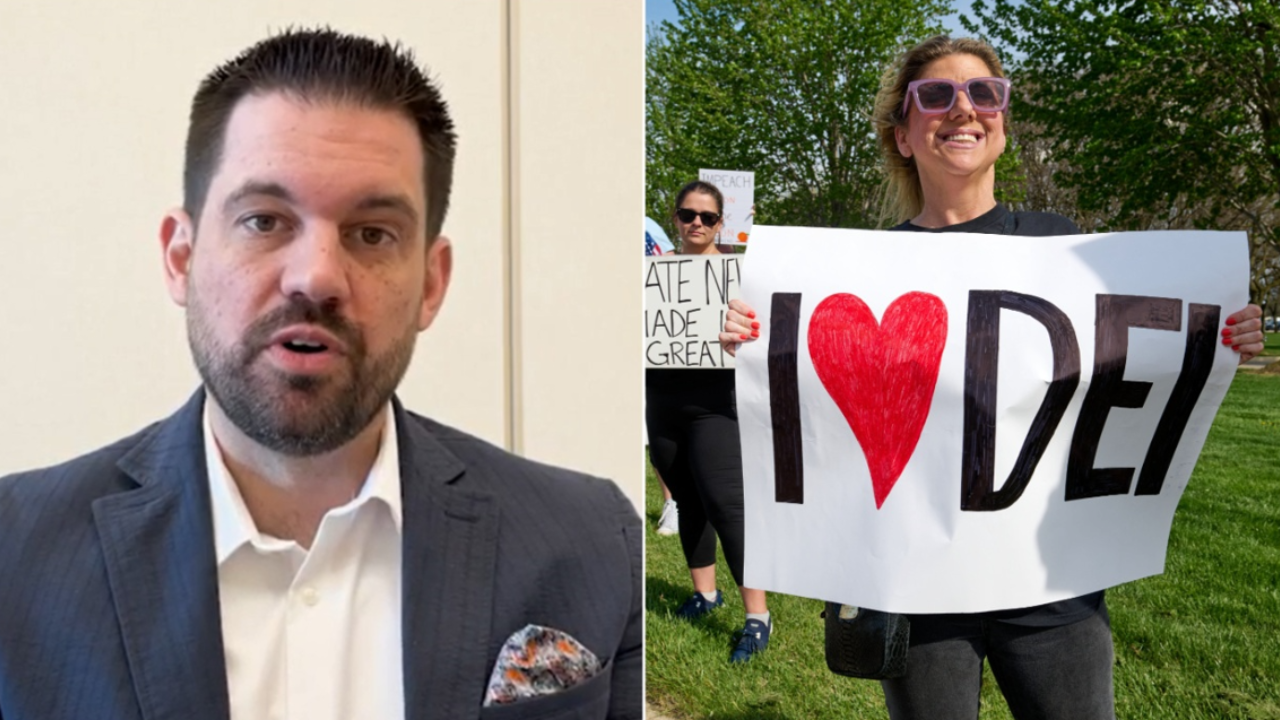
 Politics1 week ago
Politics1 week agoExpert reveals how companies are rebranding 'toxic' DEI policies to skirt Trump-era bans: 'New wrapper'
-

 World1 week ago
World1 week agoEU reaches initial deal to lift economic sanctions on Syria: Reports
-

 Technology1 week ago
Technology1 week agoAMD’s new RX 9060 XT looks set to challenge Nvidia’s RTX 5060
-

 News1 week ago
News1 week agoRead the Full ‘Make America Healthy Again’ Report
-

 News1 week ago
News1 week ago'Golden Dome' Missile Shield To Be 1st US Weapon In Space. All About It





